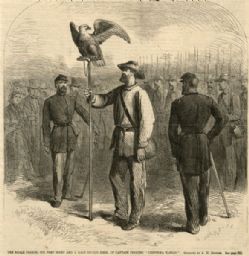How an Indian Chief Captured the Eagle that Became 'Old Abe'
A Wisconsin Civil War Story
On March 26, 1914, Chief Big Sky of the Flambeau Band of the Ojibwe Indians described how he captured an eaglet from its nest in the spring of 1861. The eaglet would later be known as Old Abe the War Eagle. Chief Big Sky traded it to the McCann family of Chippewa County, who then sold it to Civil War soldiers leaving Eau Claire for Camp Randall. Named after President Lincoln, Old Abe was carried on a special perch throughout the entire war by the 8th Wisconsin Infantry, and became a symbol of Wisconsin's Civil War history.
From Original Text: "It was shortly before the big battle, when the soldiers marched away. Sugar making time had come, and the big snow had gone, and our band was happy at work and play. One day, while hunting, I noticed in the top of a tall pine tree, a great nest of mud and sticks. I knew it to be the home of an eagle. I watched it for hours. The old birds circled and swooped about the nest, time and again, so I knew there were young ones there.
I tried several times to climb to the aerie. The work was hard, and the parent birds fought stubbornly. Even I, most agile of the Flambeaus, could not reach the top of the giant tree. Still, I wanted the little ones. I had a steel axe, which I had traded from the white men, and this I took. Then I cut down the tree. It was hard work. For half a day I hewed and chopped; other young braves laughed at me; my father was not pleased; but I persisted and at last it fell with a crash like thunder.
Then came the fight. The parent birds swept down, trying to beat me off with their sharp talons. I fought them until they flew away. Then I gathered in my prize. There had been two young birds in the nest. One was killed by the fall. The other, still an eaglet, I took to my tepee, where it was fed by the squaws and papooses with bits of meats and scraps from the camp kettle.
Three or four weeks I kept the little eagle; but when the full moon came and the weather grew warm, Thunder-of-Bees [his father] led his men down the Flambeau River to trade with the white men. Maple sugar, furs and moccasins formed our stores. I took my eaglet with me. Down there I met a man. His name was Daniel McCann and he lived at Eagle Point. He offered me a bushel of corn for my bird. I took the offer — why should I not? The eagle was no larger than a chicken, and a bushel of corn was a bushel of corn. He took it away. That is the last I ever saw of it.
But I have heard since… that McCann gave the bird to the soldiers and that it was in the big fight with them. But of this I do not know."
How to Cite
For the purposes of a bibliography entry or footnote, follow this model:
- "Newspaper Clippings, 1861-1930," Vol. 8, pages 107-108 (from the Eau Claire Leader, May 27, 1912).


